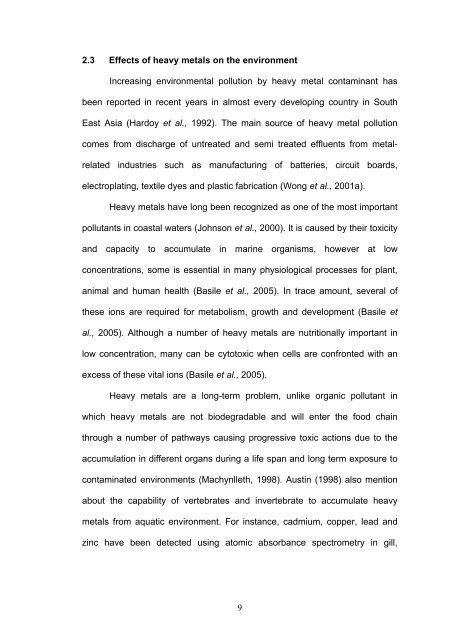IDENTIFICATION OF COPPER-INDUCIBLE GENES IN Pistia stratiotes
IDENTIFICATION OF COPPER-INDUCIBLE GENES IN Pistia stratiotes
IDENTIFICATION OF COPPER-INDUCIBLE GENES IN Pistia stratiotes
Create successful ePaper yourself
Turn your PDF publications into a flip-book with our unique Google optimized e-Paper software.
2.3 Effects of heavy metals on the environment<br />
Increasing environmental pollution by heavy metal contaminant has<br />
been reported in recent years in almost every developing country in South<br />
East Asia (Hardoy et al., 1992). The main source of heavy metal pollution<br />
comes from discharge of untreated and semi treated effluents from metal-<br />
related industries such as manufacturing of batteries, circuit boards,<br />
electroplating, textile dyes and plastic fabrication (Wong et al., 2001a).<br />
Heavy metals have long been recognized as one of the most important<br />
pollutants in coastal waters (Johnson et al., 2000). It is caused by their toxicity<br />
and capacity to accumulate in marine organisms, however at low<br />
concentrations, some is essential in many physiological processes for plant,<br />
animal and human health (Basile et al., 2005). In trace amount, several of<br />
these ions are required for metabolism, growth and development (Basile et<br />
al., 2005). Although a number of heavy metals are nutritionally important in<br />
low concentration, many can be cytotoxic when cells are confronted with an<br />
excess of these vital ions (Basile et al., 2005).<br />
Heavy metals are a long-term problem, unlike organic pollutant in<br />
which heavy metals are not biodegradable and will enter the food chain<br />
through a number of pathways causing progressive toxic actions due to the<br />
accumulation in different organs during a life span and long term exposure to<br />
contaminated environments (Machynlleth, 1998). Austin (1998) also mention<br />
about the capability of vertebrates and invertebrate to accumulate heavy<br />
metals from aquatic environment. For instance, cadmium, copper, lead and<br />
zinc have been detected using atomic absorbance spectrometry in gill,<br />
9








![[Consumer Behaviour] - ePrints@USM](https://img.yumpu.com/21924816/1/184x260/consumer-behaviour-eprintsusm.jpg?quality=85)








